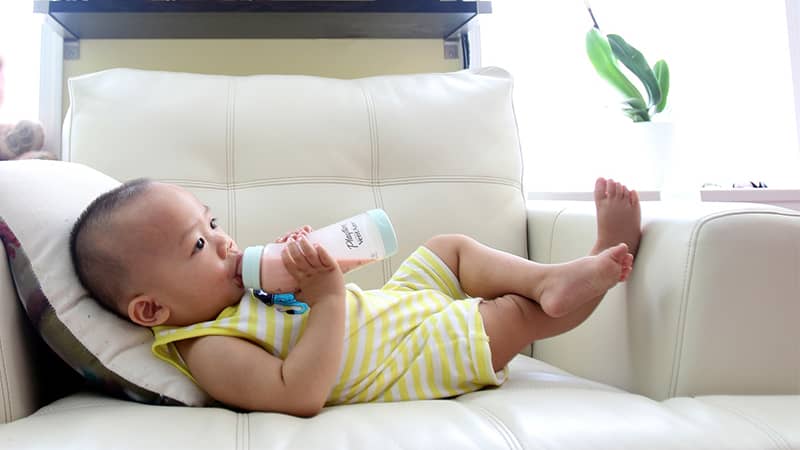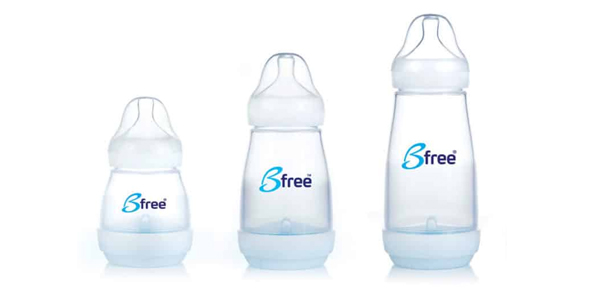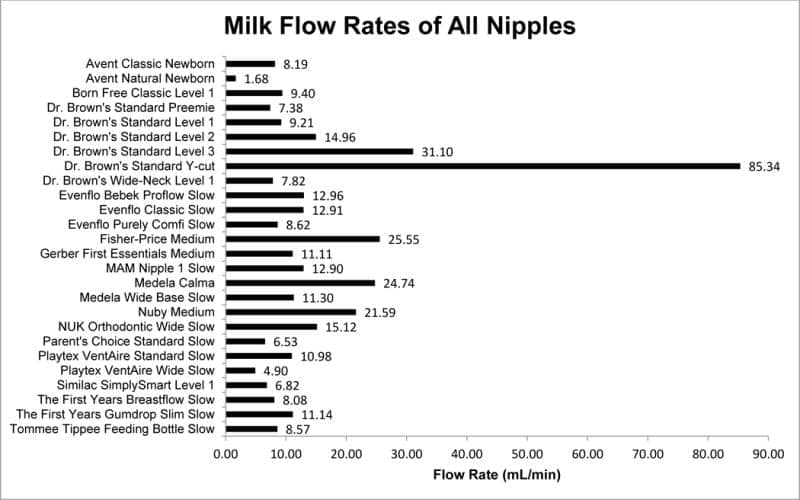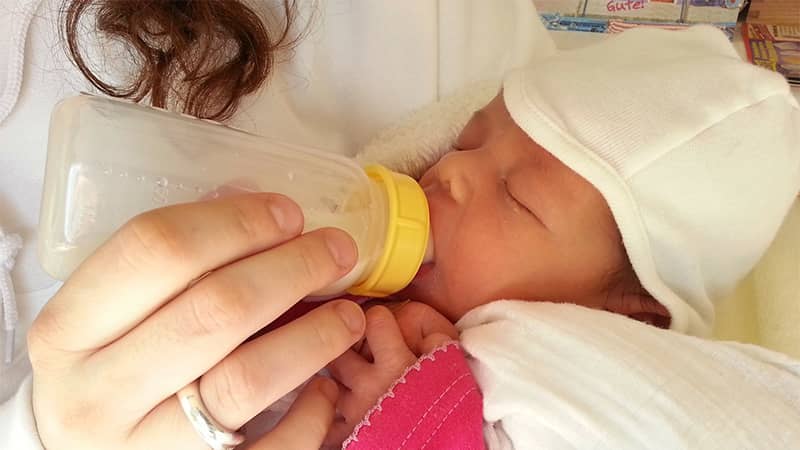Newborn infants are delicate and require constant monitoring and care. It is only with the assistance of their parents that they can take care of these basic needs.
Newborns generally need a Slow-flow nipple since fast-flow nipples are inconvenient for them. When choosing a nipple, keep a close eye on your child’s feeding patterns. We’ll take you on an educational tour of why choosing the best slow flow bottles for breastfed babies is a good idea in this blog post.
We do everything we can to meet their requirements. Using the finest slow flow baby bottles is one of a parent’s many things for their child. Newborns’ muscles and digestive systems are still developing in the womb.
Even when it comes to feeding your child, this is especially true. You’d think that placing the bottle nipple on your baby’s lips and letting the sucking happen spontaneously and instinctively. They require slow-flow bottles to avoid choking on their milk. Because they resemble the flow of their mothers’ natural breasts, they are the bottles you use when feeding them.
Editors Choice: 5 Best Slow Flow Bottles






6 Best Slow Flow Bottles in 2022
1. Dr. Brown Options + Slow Flow Bottle Set

Dr. Brown’s is a top-rated award winning brand in the baby bottles industry. Since their every bottle are quality and safe, it is the top choice of all moms. This bottle set of Dr. Brown has been specially designed with slow flow features, which will help you a lot in the field of slow controlled feeding of a baby.
Why We Choose It
Its 4 ounces 4 pieces bottle set is designed with sterilizer and BPA-free materials. It is also much easier to clean as the dishwasher is safe. A completely soft silicone nipple helps the baby in feeding comfortable way. It also has a vent system, which is effective during baby feeding develops.
Why you should buy this
You can use and remove the vent system if you want, according to your needs. Its cleaning process is very simple, and you can easily set it up after cleaning.
Highlight Features
- Award-winning bottle
- Great slow flow design
- Easy to use and BPA free design
- Clinically proven to reduce colic
- Dishwasher safe and easy to clean
2. Tommee Tippee Closer to Natural Baby Bottle

Are you looking for an original breast-like slow flow bottle for your newborn baby? Then undoubtedly, Tommee Tippee is an outstanding option for you.
Why We Choose It
One of the best features of this is that it is designed with super sensitive nipple flexes for newborn babies, and its soft silicone helps to get the real skin feel of the mother.
Its durable quality phthalates and BPA-free design make it more long-lasting and safe. Another great aspect is its optimum anti-colic nipple valve, which provides low air intake as well as extreme comfortability. Its great shaped design helps to hold the bottle in 3 different ways.
Why you should buy this
Its cleaning process is very simple because its ultra wide-neck design body helps to clean easily. Overall, 97% of consumers who use the tommee tippee slow flow bottle recommend it highly. Though the price of the bottle set is very expensive, but considering the quality, it is worthy selection.
Highlight Features
- Ultra slow flow design
- Anti-Colic, and Breast-like Nipple
- Super-sensitive bottle nipple flexes like mom
- Easy to clean and sterilizing
- BPA-free and phthalate-free
- Consumer recommended quiet flow bottle
3. Comotomo Baby Bottle

Introducing the Comotomo baby bottle, which is specially made for breastfeeding babies. Its entire design is made by following the mom’s breast. Especially where other bottles bodies are made of hard plastic materials, the Comotomo baby bottle is designed to be soft and squeezy so that you can handle it softly, as well as easy clean.
Why We Choose It
As it is 8 ounces, that’s why it is an excellent option for feeding a 3 to 6 months baby. The nipple is made of BPA-free, hygienic silicon materials, which are completely safe for babies. It has dual anti-colic vents to ensure fuss-free feeding to your baby.
Why you should buy this
The most outstanding aspect of this is that it is completely sterilizer, dishwasher, boiling water, and microwave safe. It also has a latch design to eliminate nipple confusion issues. The slow flow nipple also gives a lot of comfort to your babies in the field of feeding. Overall, this is an ideal breastfed baby bottle.
Highlight Features
- It is designed to closely mimic mom’s breast
- Soft and squeezy design
- Boiling water, Microwave, Sterilizers Safe
- Dual anti-colic vents system
- Easy to cleaning
- A great option for breastfed babies
4. Lansinoh Baby Bottles for Breastfeeding Babies

The Lansinoh baby bottle is our budget-friendly pick on this article. You will get 8 ounces 3 piece bottle in an inexpensive price range. It comes with an air ventilation system, which will reduce the intake of air.
Why We Choose It
It is a great option, especially for newborn breastfeeding babies. It reduces nipple confusion, which is clinically proven.
Another of its best features is its super-soft nipple, which helps the baby to suck naturally. As well as being a little larger in size, you can keep more milk and formula. You will get both medium and slow flow, due to which newborn babies can be fed a little faster.
Why you should buy this
Its cleaning process is relatively easy and dishwasher safe; after use, you can clean it in the way you like. It is also very compact in terms of size, which makes it easy to carry anywhere. Overall, considering price and quality, it is the best budget-friendly medium flow baby bottle.
Highlight Features
- Easy to hold, Super-soft nipple
- Budget-friendly price
- Air ventilation system
- Great medium flow baby bottle
- Easy to clean and dishwasher safe
- Clinically proven nipple to reduce nipple confusion
5. Nuk Simply Slow Flow Baby Bottle
Are you looking for large-size slow-flow baby bottles in an affordable price range? Then Nuk simply slow flow baby bottle may be another excellent option for you.
Why We Choose It
Due to its large size design, it can contain more milk and formula. As well as being a slow and medium flow, your baby feeds quickly.
Also, its soft nipple is designed a lot like a mom’s breast shape so that during feeding, your baby gets the mother’s feeling. It also has an advanced anti colic air system which helps in feeding more comfortably. As well as having multiple holes, the baby gets a lot more satisfying feeling.
Why you should buy this
The bottles are designed with BPA-free plastic materials so that you can ensure the safety of your baby. As well as being affordable price and easy to clean, it will be a great option for almost any mom.
Highlight Features
- It comes with an anti-colic air system
- Multiple nipple holes provide a natural feed.
- Odor, BPA free and stain-resistant
- NUK Simply Natural Bottles to be closest to the mom’s breast
6. Munchkin Latch Anti Colic Baby Bottles

Munchkin comes with 4 ounces 3 counts set small bottles for newborn babies. This bottle also comes with both slow and medium flow rates at the same time as our previous pick. As a result, you can choose the nipples according to your needs and do the feeding in that flow.
Why We Choose It
Munchkin is made of BPA-free plastic, which will not harm your baby’s health. On the other hand, it has an anti-colic valve that is uniquely set at the bottom of the bottle to reduce fussiness and gassiness better. Its pump stretches, ultra-flexible nipple design maintains proper latch and help the baby to get breast feel, as well as feeding pleasantly.
Why you should buy this
The great aspect of it is its beautiful cute shape design, which most babies like and helps them handle perfectly. Its wide-neck design helps in the field of easy cleaning. Considering overall things Munchkin is also the best slow flow bottles for breastfed babies.
Highlight Features
- It comes with both slow and medium flow.
- Beautiful cute shape designed bottle
- Ultra-flexible nipple design maintains the proper latch
- Wide-neck design helps to easy cleaning
- Easy to hold and budget-friendly design
- The anti-colic valve is uniquely located at the bottom.
Best Slow Flow Bottles: Buying Guide Details

Reusability
Reusable nipples might save you money over the long term, but they must be cleaned and sterilized regularly, which necessitates time and effort on your part.
On the other hand, disposable nips allow you to feed your kid whenever you want without having to clean them beforehand, but you’ll need to keep buying more and more to keep up with demand, which may get expensive and result in a lot of garbage.
Cost
The brand and durability of the nipple are the most critical factors here. When shopping for a nipple, you don’t want to skimp on quality for a lower price. Buying in bulk can help you save money without sacrificing quality.
Ease of cleaning
Sterilization and thorough cleaning are required for nipples and infant bottles. Ensure you get the bottle that enables you to use boiling water to wash in a drier manner. The use of high temperatures, which can produce BPA and other carcinogens when applied to plastic and silicon, is also a problem with these procedures.
Bottle material
You can see three types of common baby bottles:
- Glass
- Stainless steel
- Plastic (silicone)
However, silicone is currently the material of choice for the majority of today’s bottles. However, it is more costly than plastic or glass and is not as strong or clear. It’s critical, though, to seek a BPA-free soft silicone.
Bisphenol A, sometimes known as BPA, is a chemical used to manufacture reusable plastic goods. Estrogenic implies it mimics the actions of the estrogen hormone. These substances have the potential to be harmful to people, particularly babies.
Venting system

When your infant has colic, a ventilation system can help. This can be relieved with the use of ventilation systems. A baby’s venting system is critical, both for the baby and the parents. The majority of parents will appreciate the vent system because few babies are born without colic.
There are four types of bottle venting systems:
Non-vent system:
When your infant stops sucking, there is no vent system; thus, air enters the bottle.
Top Vented:
The nipple is top-vented, with several tiny holes to allow air to enter. Your infant will still consume some air because air is still bubbling through the milk.
Straw Venting:
Slits in the silicone nipples allow air to be pulled through the milk and out the other end, expelled using a straw. Because air may travel straight to the bottom of the bottle, your baby’s milk or formula will not be contaminated by it.
Bottom Venting:
A valve that you’ll find at the bottom of the bottle lets air into it when it’s upended and sucked on. Your baby’s milk or formula will remain practically air-free.
Whichever air-conditioning system you go with is preferable to none at all. If your kid is prone to colic due to excessive gas, this function will come in handy. It will also keep you from having to deal with restless nights.
Size of Bottle

The size of a bottle is determined by how much milk or formula it can carry. When determining size, consider how much liquid the bottle can carry (like milk or formula).
If you want a variety of options, try purchasing bottles of various sizes. Change the bottle and maintain the nipple that works for your kid right now.
Bottles typically range in size from four to twelve fluid ounces. It might be challenging to know exactly what size to get for your infant at any given time.
Typically, you make a decision based on the age and weight of your child. A baby or preemie needs less milk, so go for smaller bottles (starting at 4 or 5 ounces).
In the beginning, their stomach is smaller. It’s still recommended that moms of older babies use bigger bottles, such as those that hold 8, 9, or 10 ounces. When in doubt, use the bottle’s user manual chart to see how much and how often your baby should be fed.
What Is the Importance of Flow?
A baby must utilize their mouth muscles to suck on the nipple, regulate the flow of milk, and seal the airway while swallowing it to feed correctly from a bottle. This technique needs a great deal of baby coordination!
Babies that are born healthy and full-term can take any infant bottle nipple and eat it. If they need to control the milk flow, they can easily do so by adjusting the pressure they are sucking.
Their mouth muscles are powerful enough to allow them to swallow and seal their airways to prevent things from entering.
When a baby is born prematurely or with a health issue that affects muscle coordination or swallowing (such as Down syndrome), this procedure might be challenging for that baby.
Either the infant swallows the nipple, or the milk collects into a pool when the nipple enters the newborn’s mouth.
A baby’s mouth that has milk buildup can cause either leak or refuse to continue sucking.
Because of this, the infant has to swallow more quickly when the milk flow rate is high. On the other hand, slower flow rates allow the milk to pool more slowly. Taking in food will take longer since the infant will have to take their time swallowing.
High flow rates can be difficult for babies with respiratory or cardiac issues because they make it difficult for them to maintain a consistent level of oxygenation when feeding, which causes them to become exhausted and stop eating.
Low muscle tone newborns, including those with Down syndrome, will benefit from a slow-flow bottle’s longer feeding period and reduced risk of choking.
It is common for a baby who has feeding difficulties to restrict milk flow by biting on or clamping their nipple.
Furthermore, it prevents infants from exercising their mouth muscles, essential for long-term breast- and bottle-feeding periods of success.
Oral eating and speech may be impacted in the long run as a result of this as well.
Best Slow Flow Bottles: Nipple Flow Rate Study

This research aimed to show how the average flow rate can vary depending on the type of nipple being used.
But keep in mind that even while using the same nipple, newborns have varied sucking pressures and speeds; thus, this study is simply comparing nipples, not taking the baby’s impact into account.
There were 45 different types of nipples evaluated in this study, all routinely used in hospitals and in the community to feed newborns.
Ten nipples of each kind were examined as part of the research.
The amount of formula expressed in one minute was assessed using a breast pump, created as a standardized testing technique to imitate sucking.
Milk flow
The flow rates of the tested nipples ranged from 2ml/min to over 80ml/min. It was surprising to learn that the flow rate does not always correspond to what the nipple company claims.
Premature nipples from Enfamil and Similac, for example, were quicker than slow or usual flow nipples. Enfamil’s slow nipple was faster than Similac’s, too.
Although it was tested with standard-thickness formula, it is generally used with thickened milk; the Avent Natural Newborn was the slowest while DR. Brown’s Y nipple was the quickest.
Variability
The flow rate between nipples of the same kind varied greatly, as was discovered. Only ten out of the 45 nipple varieties studied exhibited any variance in their nipples more than ten percent.
As an example, the most consistent brand was DR. Brown’s, with six of its nipples showing slight variance. Other brands were Tommee Tippee and Medela Calma. Nineteen of the 45 nipple varieties examined had a difference between their nipples of more than 20 percent.
We usually ascribe the quantity of milk a baby feeds to other variables like tiredness, but according to the study, how much a baby feeds is also affected by the nipple. It’s critical to take this into account. According to the findings of this study, if your kid isn’t eating correctly, switching to a nipple with less fluctuation or trying many nipples of the same kind may be beneficial.
Notably, only negative pressure (such as sucking) was considered in the research; no consideration was given to positive pressure, which may be present in newborns. Among the other intriguing discoveries were the following:
- A buildup of suction pressure on the nipple from overtightening the nipple on the bottle might cause it to collapse, making it difficult for the child to take suckings from the nipple.
- With more fluid in the bottles, the nipple experiences increased gravitational pressure, resulting in high flow.
- Less fluid also implies less pressure; thus, the flow is slowed down as well.
Source of this study: 10babygear.com; NCBI
What Are The Benefits Of Using A Slow Flow Nipple?
Feeding a newborn requires a slow flow nipple because it allows the baby to suck gently without being overwhelmed, which guarantees the baby receives the correct amount of milk each time.
Feeding an infant with an incorrectly sized nipple might lead to health issues. Because of the increased flow of a giant nipple, the infant will have to swallow more food faster. Eventually, the stomach would get too full to accept any more milk, causing the baby to vomit a lot.
Babies who consume too much air suffer from acid reflux. If you start with a slow flow nipple, your child won’t have to deal with any of these unpleasant side effects. Baby nipples that are too big might cause stomach problems because of the extra pressure they put on the baby’s abdomen.
Best Slow Flow Bottles: FAQs
Do breastfeeding babies need a slow flow bottle?
The short answer is “Yes.” Slow flow nipples are really important for babies because their milk flow rate is much like the mother’s breast to the baby. However, it may not be applicable to all babies. Many babies are seen to feel very uncomfortable in slow flow, due to which they need a wide neck nipple.
How do I switch from breast to bottle?
To easily shift your baby from breast to bottle, Here are some simple steps you can take.
When your baby is not hungry, offer him breast regularly. Most of the time, try to feed him in a bottle, then breastfeed him after almost complete feeding. Continue like this when you recognize that he feels comfortable eating in the bottle, then completely stop breastfeeding.
Why does my baby keep gasping for air?
The main cause of noisy breathing in infants children is laryngomalacia, which usually occurs when the baby’s larynx is soft and floppy. When your baby breathes, his larynx part is behind the vocal cords, which temporarily blocks the airways.
Can mixing formula and breastmilk cause an upset stomach?
Feeding formula and breastmilk together can lead to an upset stomach. So it is better to avoid.
Can you overfeed a breastfed baby?
Feed your baby comfortably whenever he is hungry, but do not try to overfeed, as this will create objection towards the baby’s breast. Try to feed as much as needed.
Final Verdict
Hopefully, our complete guide and Guide about the best slow flow bottles for breastfed babies will help you find a suitable bottle for your baby. Try to follow the nipple flow rate study; before buying the slow flow baby bottle, you must try to follow our buying guide to find the exact bottle that loves your baby.
Sources
Read More
- Best Bottles for Thickened Formula
- Best Bottle for Baby with Lip Tie
- Best Bottle for Baby with Small Mouth
- Dr Brown vs Avent Bottles
- Best Bottle Drying Racks
Table of Contents

